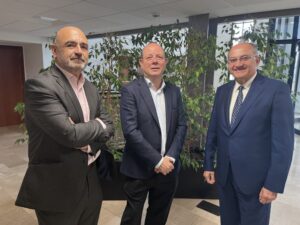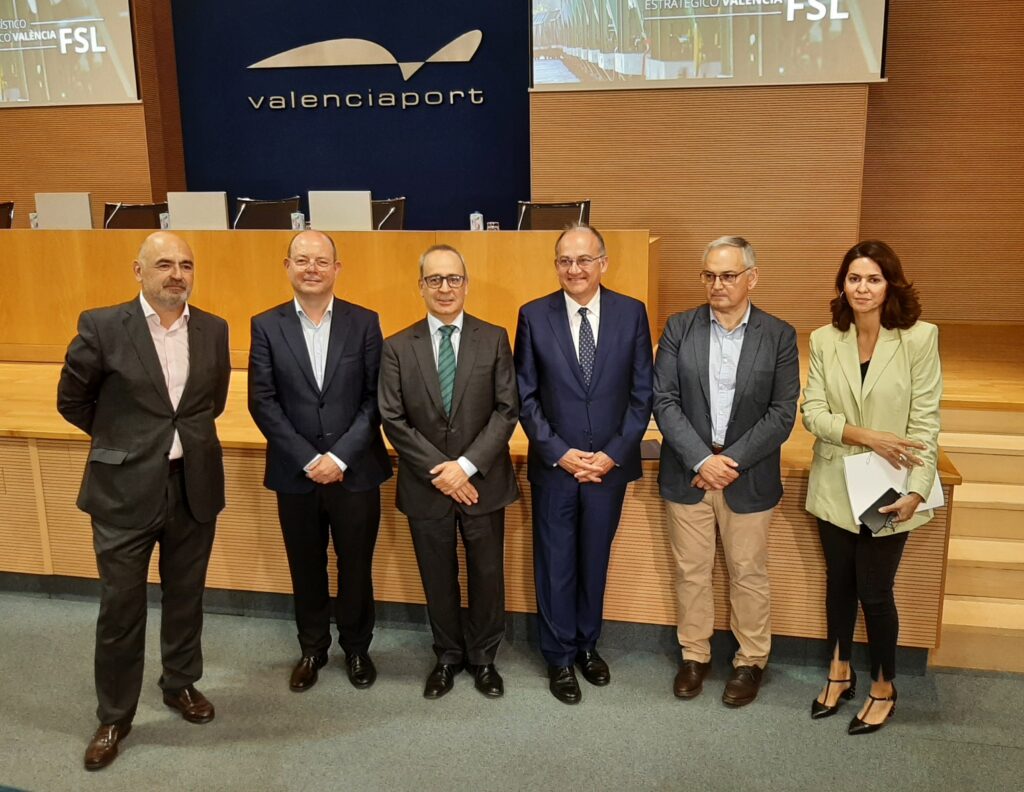
- Located in the Mediterranean Corridor, it is a key strategic node in the interconnection, interoperability and intermodality of transport services
- It will reinforce standard gauge train traffic between Valencia and the French border, will complement the Port and is linked to the development of the ZAL of the Port of Valencia and Mercavalencia
- It will have 5G infrastructure for the provision of advanced logistics services, facilitating the ‘intelligent’ management of goods traffic and speeding up intermodality
València, May 30th, 2023.- The intermodal terminal, promoted by Adif in the València-Font de Sant Lluís logistics node, will have the capacity to operate 150,000 Intermodal Transport Units (ITU) and handle up to 2,600 freight trains per year, and its two gantry cranes will have a storage capacity of 2,500 TEU/year (unit of measurement equivalent to a 20-foot container).
These data and its strategic character to reinforce the transport of goods in our country have been highlighted today in a meeting held in Valencia, in which Adif and the Port Authority of Valencia (PAV) -as promoters- and Grupo Alonso -as operator of the intermodal terminal-, have presented the project of the new intermodal logistics hub of the Valencian capital to representatives of the sector.

(Izquier-derecha): Fátima Fayed, gerente de Valencia Plataforma Intermodal y Logística (VPI Logística) en la Autoridad Portuaria de Valencia; Josep Vicent Boira, Comisionado del Gobierno para el desarrollo del Corredor Mediterráneo en España; Joan Calabuig, presidente de la Autoridad Portuaria de Valencia; Luís Vicente Moreno, director de Servicios Logísticos de Adif; Jorge Alonso, CEO del Grupo Alonso; José Luís Soria, gerente de Servicios Logísticos del Área Este de Adif
Facilities and services with an international dimension
Located on the Mediterranean Corridor, next to the Port, València-Font de Sant Lluís forms part of the Trans-European Transport Network and constitutes a key strategic node in the interconnection, interoperability and intermodality of transport services, which will enable standard gauge trains to run between València and the French border. The centre will also complement the Port of Valencia and is linked to the development of the Logistics Activities Zone (ZAL) of the Port of Valencia and Mercavalencia.
José Luis Soria, manager of Adif’s Eastern Area of Logistics Services, explained that the new node will have 5 different areas: the intermodal terminal, which represents an investment by Adif of more than 35 million euros, the environmental area with warehouses for the treatment of cargo and a wide range of complementary transport activities (heavy goods parking, auxiliary services for personnel, etc.). “All of this will make up a node with a formidable operational capacity that, without doubt, means a before and after in the transport infrastructures of the Valencian Community”, he pointed out.
Likewise, the intermodal terminal will have 5G coverage, within the framework of the plan that Adif is developing in ten of the main logistics terminals in Spain considered strategic, with the aim of boosting their digitalisation and, with it, the automation of processes and the reduction of costs in the transport of goods by rail.
The 5G infrastructure enables the provision of advanced logistics services, with partial or total automation, and facilitates the ‘intelligent’ management of freight traffic, thus speeding up transits and facilitating intermodality. Moreover, it will promote the interconnection of the main transport nodes of the railway system in an efficient way, resulting in a more sustainable and intelligent mobility.
The construction works for the València-Font de Sant Lluís intermodal and logistics terminal (1st phase), as well as the 5G coverage, will receive European funding through the Recovery, Transformation and Resilience Plan. Funded by the European Union – NextGenerationEU.
Boosting activity and generating rail and maritime business
As the owner of the facilities, Adif will manage the shunting activities, as well as the nodal capacity in coordination with the capacity of the different lines accessing the terminal. In addition, it will guarantee full access to the Mediterranean Corridor and ensure the operation of vehicles and locomotives in standard gauge.
Adif and the Port Authority of Valencia (PAV), as promoting entities, will carry out the following functions:
- to boost the activity between public and private actors in order to promote investment in the hinterland and to work proactively with external agents in the generation of business related to rail and maritime activity;
- defining the strategy of each business unit in relation to the generation of added value and the coherence of the services offered;
- management of common spaces.
Grupo Alonso, as the operating company for a 14-year concession period – extendable for a further 6 years – will focus its work on the commercialisation of the terminal, among other functions.
Jorge Alonso, president and CEO of Grupo Alonso, stressed that the objective is to make Fuente de San Luis an intermodal terminal that is “flexible, modern, innovative, in short, 21st century”, adding that “our aim is to offer our customers all possible services for all types of goods within the terminal itself”. In this way, “we envisage that it will have a dry and cold warehouse, a workshop for repairing containers and semi-trailers, cooling towers, an administration building and automated access and exit”.
For its part, València Plataforma Intermodal-ZAL will be responsible for the marketing and operation of the greenfield site. Joan Calabuig, president of the PAV, stated that “the Font de Sant Lluís intermodal station project is a clear example of institutional collaboration between local (València City Council), regional (Generalitat Valenciana) and central (Mitma, State Ports, Port Authority and Adif) administrations and of a public-private management model”. He also stressed that “this initiative, for which Valenciaport has committed 15 million euros, is part of the Valencia Port Authority’s decarbonisation plan, which contributes to the goal of sustainability. The project is also part of the PAV’s railway strategy with 240 million euros, which has launched actions such as the Madrid-Valencia-Portugal Railway Motorway, the first initiative of its kind in Spain and whose main objective is to ‘put the lorries on the train’, decongesting the road”.
In the same way, Calabuig has highlighted that “Valenciaport’s investment plan in this area is completed with initiatives such as the railway access to Sagunto, several investments in the Cantabrian-Mediterranean Corridor; the reorganisation and extension of the internal network of the port of Valencia, the FSL intermodal station, the Intermodal in Sagunto, the PLAZA terminal in Zaragoza, the Madrid-Coslada Dry Port, the future Madrid-Vicálvaro terminal or the agreements with intermodal logistics projects in Albacete, Alcázar de San Juan, among others”.
Fatima Zayed, manager of Valencia Intermodal and Logistics Platform (VPI Logistics) at the Port Authority of Valencia, presented the sketches of the Special Plan to organize the intermodal area. In her presentation, the distribution of surfaces and their uses, as well as the facilities and services that are contemplated in the area, were presented.
Rail freight transport, a challenge
Rail freight transport is one of the main challenges in our country in order to increase the amount of freight, which is currently transported by road, with the aim of advancing towards a more sustainable, intelligent, competitive, multimodal and safe mobility.
In this context, work is being carried out on different lines of action: national and European corridors, connections with logistics and port infrastructures, rail motorways, the development of modern and digitalised logistics areas and intelligent intermodal logistics chains.
The València-Font de Sant Lluís logistics node is part of the Safe, Sustainable and Connected Mobility Strategy 2030 of the Mitma (Ministry of Transport, Mobility and Urban Agenda), aimed at effectively increasing rail freight transport by promoting strategic intermodal nodes located on priority freight axes.

